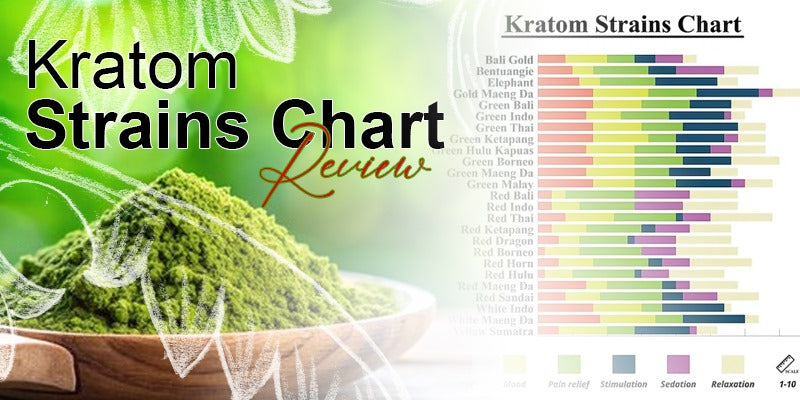
Kratom is a tree from the coffee family that grows in Southeast Asia. Its scientific name is Mitragyna speciosa. It is mainly found in Thailand, Malaysia, and Indonesia. Its leaves are dried and used to make tea, sold as powders, capsules, or extracts. In some cases, kratom leaves are also smoked like tobacco. Kratom comes in different strains, and each one works in its own way. Some strains boost energy and focus, while others help with relaxation and calmness. Knowing the difference is important because the strain you choose will shape your overall experience.
What are kratom strains chart?
A kratom strain simply means the type of kratom leaf you’re using. The way the leaves are dried or fermented gives them their colour—red, green, white, or yellow. The region where they grow shapes the mood and taste, since soil, sunlight, and climate change the alkaloid balance. That’s why no two strains feel exactly the same.
Kratom strains chart based on vein colours
Red vein kratom
Red vein kratom is easy to recognize by its red-coloured veins. It is usually dried indoors with little or no sunlight, which helps preserve its alkaloid structure. Red strains have a higher concentration of 7-hydroxymitragynine (about 2% or more) and lower mitragynine (around 10–12%). That is why they are considered heavier in profile compared to other types.
Green vein kratom
Green vein kratom comes from leaves with green veins and is dried both indoors and outdoors, which balances its alkaloid levels. Greens typically contain 15–20% mitragynine and 0.5–1.5% 7-hydroxymitragynine. As a result, they fall between red and white strains in terms of overall character. Therefore, many users view green strains as a balanced choice.
White vein kratom
White vein kratom has pale veins and is usually dried in direct sunlight, sometimes followed by fermentation. This process increases the sharper alkaloid content, with mitragynine levels around 20–25% and very low 7-hydroxymitragynine (less than 0.5%). That is why whites are often considered brighter and more stimulating in profile.
Yellow/gold vein kratom
Yellow and gold kratom are not natural vein colours but are created through special processing. Some leaves are fermented, while others are dried for longer periods or blended from different vein types. This method changes the alkaloid balance, giving them 12–15% mitragynine and about 1% 7-hydroxymitragynine. Therefore, they are seen as smoother and more subtle compared to reds and whites.
Strains of Kratom based on regions
The region where kratom grows has a strong impact on its character. Soil type, rainfall, and climate affect the alkaloid profile, as well as the taste and mood of the strain. Rich volcanic soils can create smoother and more balanced leaves, while sandy soils tend to give a sharper and more stimulating edge. This is why the same vein colour can feel different when grown in Bali, Borneo, or Thailand.
Bali kratom
Bali kratom grows on the Indonesian island of Bali, where the rich soil and humid weather create leaves with a balanced profile. That is why Bali kratom is considered one of the most versatile types. Red Bali is often seen as heavier, while Green and White Bali feel lighter and more uplifting. Many people view Bali as a reliable all-rounder.
Borneo kratom
Borneo kratom comes from the island of Borneo, one of the largest islands in Southeast Asia. The tropical climate and dense forests give these leaves a smoother but stronger character compared to Bali. As a result, Borneo strains are often chosen by people who want something deeper and heavier in profile.
Maeng da kratom
Maeng Da kratom is different from most other strains because it was created through selective breeding in Thailand to increase strength. Later, it was also grown in Indonesia, where it became widely available. That is why Maeng Da is considered one of the most powerful kratom types.
Super Malay kratom
Malay Super kratom is grown in Malaysia, where the climate helps the leaves develop a longer-lasting profile. Green Malay is especially popular because it is steady and consistent, making it stand out among regional strains. That is why Malay kratom has a strong reputation for reliability.
Thai kratom
Thai kratom originates from Thailand, where hot and sunny conditions give the leaves a sharper and more stimulating profile. Therefore, Thai kratom is often chosen for tasks that need more endurance and focus. Over time, it has become one of the best-known kratom varieties worldwide.
Indo Hulu kratom
Indo Hulu kratom comes from Indonesia, one of the world’s biggest kratom producers. Because it grows in many regions, Indo kratom can vary, but it is usually smoother and less intense compared to Thai or Maeng Da. That is why Indo strains are often recommended for people new to kratom.
Kratom Strains Chart: Vein Colour and Regional Effects
|
Vein Colour |
Region (Example) |
Combined Character / Feel |
Typical Alkaloid Balance |
|
Red |
Bali |
Deep, grounded, heavy |
Mitragynine: ~10–12% <br> 7-Hydroxy: ~2%+ |
|
Red |
Borneo |
Smooth, dense, heavier |
Mitragynine: ~11–13% <br> 7-Hydroxy: ~2% |
|
Red |
Maeng Da |
Rich, strong, long-lasting |
Mitragynine: ~12–14% <br> 7-Hydroxy: ~2–2.5% |
|
Green |
Malay |
Balanced, steady, reliable |
Mitragynine: ~15–20% <br> 7-Hydroxy: ~0.5–1% |
|
Green |
Bali |
Brighter, mildly uplifting |
Mitragynine: ~16–18% <br> 7-Hydroxy: ~0.5–1% |
|
Green |
Indo |
Gentle, adaptable |
Mitragynine: ~15–17% <br> 7-Hydroxy: ~0.5–1% |
|
White |
Thai |
Sharp, crisp, energising |
Mitragynine: ~20–25% <br> 7-Hydroxy: <0.5% |
|
White |
Borneo |
Clean, clear focus |
Mitragynine: ~19–23% <br> 7-Hydroxy: <0.5% |
|
White |
Maeng Da |
Strong, long-lasting lift |
Mitragynine: ~22–25% <br> 7-Hydroxy: <0.5% |
|
Yellow / Gold |
Bali |
Blends Smooth, mellow hybrid |
Mitragynine: ~12–15% <br> 7-Hydroxy: ~1% |
It's important to note here that these numbers are approximate ranges based on common lab reports; actual levels can vary by harvest, soil, and processing methods.
How can you choose the right kratom strain?
Picking the right kratom strain is less about rules and more about matching your lifestyle. Some people choose by time of day like lighter strains in the morning, steadier ones in the afternoon, and heavier ones at night. Others go by taste and smoothness, since certain strains are earthier or more bitter than others. Many regular users even rotate strains, so their body doesn’t get used to just one type.
Quick checklist for buying quality kratom strains
|
Do’s |
Don’ts |
|
Buy from vendors with third-party lab testing |
Don’t buy from sellers who hide lab results |
|
Check for pure kratom with no fillers |
Avoid products with additives or artificial flavours |
|
Read customer reviews for consistency |
Don’t trust vendors with no history or transparency |
|
Pay fair prices that reflect quality and testing |
Be cautious of deals that look too cheap |
|
Look for vendors who share origin and processing details |
Don’t buy from sources that keep information vague |
FAQs
What’s the strongest Kratom strain?
Maeng Da is often called the most powerful strain. It’s known for long-lasting and intense effects. Because of its strength, it’s usually best for experienced users.
Which strain is best for relaxation?
Red Bali and Red Borneo are favourites for their calming and soothing nature. They help unwind after a long day and are often used in the evening.
Which strain is best for beginners?
Green Malay and Green Indo are beginner-friendly options. They provide a steady balance between energy and calm. Their effects are smooth and not too overwhelming.
Can I mix Kratom strains?
Yes, many users blend strains to tailor their experience. For example, mixing white and red can give both focus and relaxation. Start small to find the right balance.
How long do effects last?
Kratom effects generally last between 3 to 6 hours. Duration depends on the strain, your body, and the dose. Stronger strains and higher amounts usually last longer.
